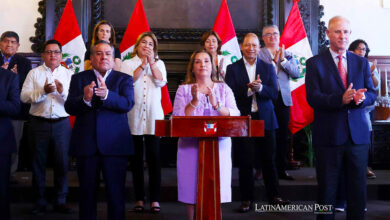Opinion: Is It Time for Pedro Castillo to Resign as President of Peru?
The president of Peru, Pedro Castillo, has had a mandate accompanied by scandals, accusations, and criticism. It's time for him to step aside

Photo: TW-PedroCastilloTe
LatinAmerican Post | Santiago Gómez Hernández
Listen to this article
Leer en español: Opinión: ¿Es momento de que Pedro Castillo renuncie como presidente de Perú?
From the moment he came to power, Pedro Castillo has not had a moment of calm. The division of parliament and the difficulties that the former teacher has had in forming his cabinet, have left him more time defending himself than governing. Given this difficult scenario, the question is how appropriate is it for Pedro Castillo to remain or resign as president of Peru?
Scandals of the Government of Pedro Castillo
Pedro Castillo has not even completed a year and a half of his government, but he has already faced 2 impeachment processes, investigations of his own corruption and that of his sister-in-law. He has also suffered criticism and attacks on innumerable members of his cabinet, which he has had to modify, almost monthly. Few have been the ministers who have remained since the beginning of the Government.
Here the truth no longer matters if everything is "a political persecution" or serious questioning of the president. Whether true or false, what is certain is that Castillo has not been able to govern as he should and will not be able to do so as long as Congress remains so divided. He has changed his cabinet in a thousand ways and has not been able to send a message of calm to supporters or opposition.
Today, neither president nor Congress have the legitimacy of the Peruvian people. A survey by the Institute of Peruvian Studies said that 85% of the country disapproves of the management of Congress, and 67% of President Castillo.
Political Crisis in Peru
The crisis that Pedro Castillo is experiencing first-hand today is not exclusive to the former leader of Peru Libre. For several years, most of the last former Peruvian presidents have been investigated for corruption cases. Additionally, Peru has also had 5 presidents since 2016, which shows the little political stability that the Andean country is experiencing.
But this instability was evident to Castillo from the moment he arrived in government. Castillo came from activism and trade unionism, under a platform of a traditional leftist party. But with the multiplicity of parties in the 2021 elections, the current president went to the second round with only 18% of popular support, which indicates that he was not the first option for more than 80% of Peruvian voters. This meant that his arrival at the presidential palace lacked sufficient legitimacy among the other parties. Precisely the Peruvian opposition has already shown that they barely smell the blood of a president, the parliament acts like piranhas and the opposition will try to control the government as much as possible.
Castillo experienced this same thing, who, in just over a year, has already emerged victorious from 2 impeachment attempts by the Assembly. The votes are divided. The opposition has enough to control Castillo and put any member of the government at risk, but it does not have enough to remove him. They are at an impasse.
So, if the government of Pedro Castillo has not managed to get enough support from the legislature, a solution to the current crisis may be his resignation. Without Castillo at the head, the ruling party can send a message of dialogue to the opposition and get out of the current political mess. The presidency would be occupied by the current vice president: Dina Ercilia Boluarte, who is also the Minister of Development and Social Inclusion. The problem is that Boluarte itself is a figure that divides, even within Peru Libre. In January, she was expelled from the party for her criticism of the movement's leader, Vladímir Cerrón.
However, Castillo's critics believe that a voluntary resignation by Castillo would be unthinkable. Due to the investigations that are being carried out today against the president and relatives. If the president resigns from office to send a conciliatory message to the opposition, his judicial future could be compromised. As soon as he leaves the presidency, he loses the jurisdiction that prevents him from being prosecuted. This suggests that Castillo is afraid of leaving prematurely.
Read also: The Bukelization of Mexico: The Influence of Nayib Bukele
Furthermore, if the Peruvian opposition has shown anything, it is its unwillingness to dialogue. Castillo did not last even 6 months in office when the first vacancy process began. Nothing guarantees that Castillo's successor will not face an equally hostile Congress.
The healthiest thing for Peru today is that it is Castillo himself and the opposition who recognize the impasse they have reached and that does not allow stability in the country. Castillo must agree to give bureaucratic positions to the other parties, give in to the most extreme factions that have divided so much, and create a joint government plan with the opposition. If it is achieved, surely the president will not go down in history for fulfilling his campaign promises, but history will be able to recognize his desire to carry out an almost impossible administration.
Regional Elections
However, next Sunday, October 2, an event may occur that could further shake Peruvian politics. Regional and municipal elections will be held in the coming weeks. Peruvians will elect 25 regional governments, 196 provincial and 1,694 district mayors. This may give a boost, either to the Government or to the opposition. Positions such as mayor of Lima are at stake, and this may give a more accurate picture of the political environment in Peru.
An electoral debacle or a resounding victory on one side could unbalance the balance at the national level and allow solutions to be reached.




